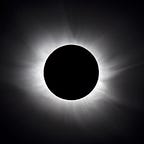Supersonic eclipse-chasing: Concorde’s 74-minute Totality
Back in 1973, Concorde raced the Moon’s shadow along the the Tropic of Cancer
During a Total Eclipse of the Sun, the Moon’s shadow races across the surface of the Earth at over twice the speed of sound. Those standing underneath get a brief glance at Totality as the shadow rushes over them; a couple of minutes is typical.
But what if you were moving at the speed of sound during Totality? That was the theory behind a very special flight of supersonic jet Concorde back in 1973 that sought to keep up with the Moon-shadow for as long as possible.
It worked. Those on board a French prototype of Concorde on June 30, 1973 — incidentally during the moments of the Summer Solstice — gazed at Totality for a gob-smacking 74 minutes.
Thanks to its top speed of 1,300 miles per hour (that’s Mach 2), scientists from Los Alamos National Laboratory, the Paris Observatory, the Kitt Peak National Observatory, Queen Mary University of London, the University of Aberdeen and the Centre Nationnal de la Recherche Scientifique (CNRS) became the most experienced and successful eclipse-chasers in human history — and likely its future, too.
After taking off from Gran Canaria, they cruised at 55,000 ft — enough to also see the curvature of the planet — and studied the solar corona, the chromosphere effect, the intensity of the sun’s light, and the effect of sunlight on the atmosphere, before landing in Chad. You can read more here.
It wasn’t just an unbelievably long eclipse for those in Concorde; those standing on the Line of Totality below in the Sahara Desert saw a whopping 7 minutes and 4 seconds of Totality — the longest until 2186, hence the decision to try a spot of supersonic eclipse-chasing in Concorde.
PS: Thanks for taking the time out to read my post! If you like my blog, please …
1) Leave a comment or press ❤ to recommend it
2) Share it with your network
3) Follow me for future posts (@thenexteclipse)
5) Spend a few dollars on one of my USA eclipse travel guides
6) Visit www.WhenIsTheNextEclipse.com
